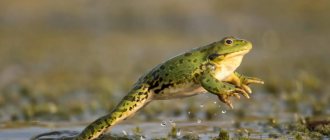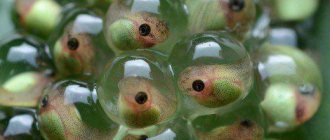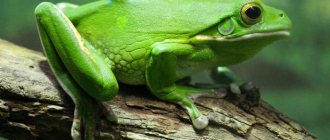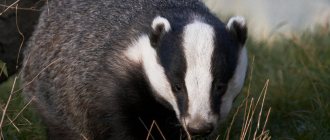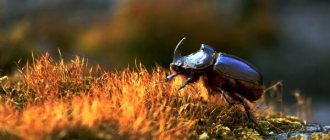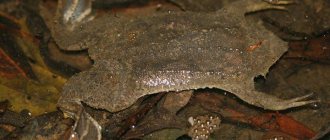Appearance
The frog has a large and flat head, on the side of which there are bulging eyes . Along with other land vertebrates, frogs have upper and lower eyelids. Under the lower eyelid of the amphibian, a nictitating membrane is found, which is called the “third eyelid”. Behind the eyes of an amphibian there is a special area covered with thin skin called the eardrum. Two nostrils with special valves are located above a huge mouth with small teeth.
The frog's front legs are characterized by the presence of four rather short toes. The hind legs of the animal are strong and well developed, equipped with five fingers, the space between which is covered with a specially leathery membrane. There are no claws on the animal's fingers. The only excretory part is located in the posterior region of the frog's body and is represented by the so-called cloacal opening. The frog's body is covered with bare skin, quite thickly lubricated with special mucus, which is abundantly secreted by the animal's numerous special subcutaneous glands.
This is interesting! The size of frogs depends on the species, so European frogs most often do not exceed one decimeter, and African goliath frogs are a kind of record holder in terms of size, therefore, with a half-meter size, they weigh several kilograms.
The size of an adult frog varies markedly depending on the species, but most often varies between 0.8-32 cm. The color of the skin is also very diverse and can be brownish, yellow, green or an unusual variegated color. Many members of the family prefer to camouflage themselves with herbaceous vegetation, foliage or branches, and therefore have characteristic green, gray and grayish-green skin.
War coloring, as a rule, indicates that the frog is poisonous, which is explained by the presence of special glands on the skin that produce substances that are toxic and harmful to human or animal health. Some frogs easily mimic, imitating dangerous amphibians to escape from enemies.
Bright-eyed tree frog
This genus includes representatives of 8 species of tree frogs, among which is the red-eyed tree frog. The length of its body does not exceed 7.5 cm. Due to the fact that the main color is green, the tree frog can easily camouflage itself among dense foliage. The base of the paws, as well as the sides, are colored neon blue. It has a yellow pattern on it. Fingers are orange. This coloring makes representatives of the red-eyed frogs the most striking of their kind. The bright color is recognizable even by predatory organisms that are colorblind by nature. In nature, this tree frog prefers to climb higher, to the middle or upper tiers of trees.
The tree frog got its name due to its amazing red eyes with a vertical pupil. They are disproportionately large compared to the entire body, so in the dark the illusion of a large animal is created. This deters many predators. Like other representatives of this species, it hunts insects and sometimes catches small lizards and arachnids. It breeds almost all year round. This is due to the fact that the red-eyed frog lives in tropical forests. The tree frog protects itself by its bright appearance, so it is not poisonous.
Varieties of frogs
There are more than 500 species of frogs in the modern world. To simplify perception, representatives of amphibians were conventionally divided into the following subfamilies:
- toad-like;
- scythe-dactyls;
- real;
- African forest;
- dwarf;
- Discopals.
The following are considered the most amazing and unusual frogs in the world:
- transparent (glass) - individuals grow up to only 2 cm, have colorless skin through which all internal organs are visible;
- Cocoy poison frogs are miniature amphibians that produce a strong toxic venom in their skin that is superior to the most dangerous snakes in the world;
- hairy - unusual amphibians in which hair grows on the back and serves as a kind of respiratory organs;
- Goliath frogs are one of the largest tailless frogs, growing up to 40 cm and weighing up to 3.5 kg;
- pointed-nosed arboreal - have an unusual nose;
- bullfrogs are large individuals that produce a deafening croaking sound;
- flying frogs - small amphibians famous for their long jumps; they are capable of jumping up to 12 meters.
Researchers claim that a large number of frog species are still unknown to humanity. Therefore, scientists are happy to continue to study the animal world in anticipation of new discoveries.
Blue Darter / Dendrobates azureus
The cute creature, as seen in the photo, with a characteristic blue coloration, prefers savannas and tropical rainforests, and feeds mainly on small insects.
Even a small concentration of poison is enough to kill large natural enemies, and deaths among humans have also been recorded in history. They grow up to 5 cm in length, and live among the foliage, gathering in groups of up to 50 individuals.
Despite the mortal danger, wildlife lovers keep the American inhabitant as a pet.
10
Why do frogs grow extra legs?
The absence of one paw from the symbol of wealth can be explained in any way (according to legend, the fourth was taken away by Buddha for sins), but individuals with extra paws have long puzzled scientists, and they have sinned on chemical waste. It turned out that amphibians become victims of chemicals that did not get into water bodies, the Ribeiroia parasites, which have a complex life cycle that begins in snails. As they grow up, they look for a new host, which becomes a fish or tadpole. And since the tadpole is in the process of growing legs, the process of reproduction of new molecules is disrupted and spreads to other parts of the body, causing the growth of new limbs. The maximum number of legs observed on a frog by humans was 10 on each side.
How to get rid of these animals?
Often tree frogs overwhelm residents of rural areas with their invasion, singing all night long under their windows. Not every person is able to appreciate such frequent and loud performances. There is an irresistible desire for peace and quiet. How to get rid of tree frogs? There are several options. Draining the pond is the most global method. You can install turntables, which will frighten frogs, because they react very sensitively to any movement. A more cruel method: spray the banks with an insecticide, thus depriving amphibians of their food supply.
Why put frogs in milk?
Many people know that in the old days it was customary to do this. It was believed that the cold amphibian prevents the heating of the product, and therefore slows down its souring. In the absence of refrigerators, this was completely justified. A similar sanitary and hygienic ritual was practiced not only in Rus', but also in many other European and Middle Eastern countries.
For a long time it was considered a superstition, but the milk really did not turn sour and biologists became interested in the phenomenon. It turned out that the skin of the amphibian has special cells capable of producing natural antibiotics, without which existence in a humid environment, especially in the tropics, would be impossible. Due to fungal and bacterial infections, for which such conditions are heaven on earth, amphibians would not have time to look back before they would be covered with mold. Natural antibiotics also change depending on the habitat. In amphibians galloping along our native shores, they are not so strong, but the peptides produced by the skin have sufficient antimicrobial action to prevent several liters of milk from souring.
Lifestyle
Initially, dart frogs settled along the banks of streams, swamps and rivers. They love shady areas, so they are easy to spot in forests and mountains where it often rains.
They live both in low-lying areas and at altitudes up to 2000 m above sea level. Frogs spend time not only near the pond, but also in the trees. They easily overcome heights, move along branches and jump from tree to tree.
You can eat, but you can't touch
One of the most powerful (and according to some sources, the most powerful) poisons of animal origin is the mucus of the tiny Colombian cocoa frog, whose weight does not exceed 1 g and height - 3 cm. But one such individual is enough to kill 1,500 people. At the same time, its poison is harmless when eaten, but the slightest amount of it that gets on a wound causes immediate paralysis and death. There is no antidote for it. By the way, the amphibian body does not know how to produce poison; it enters it with food.
The local Choco Indians, with great difficulty, obtain several specimens of cocoa in the jungle and hold them over the fire so that the poison appears on the skin, after which they smear their arrows with it. When dried, it retains its properties for up to 15 years.
Striped leaf climber / Phyllobates vittatus
These colored frogs, living in the southwest of Costa Rica, with their striking appearance warn that they are dangerous and it is better to avoid these wonderful creatures.
Easily identified by the characteristic yellow stripe running down the back. The stripes run along the head and along the sides of the abdomen, which is why the frog received its specific name.
It is not possible to notice it right away, since it prefers to hide in crevices and between stones. The poison, when it gets on human skin, causes severe pain and can even lead to paralysis.
11
Range, habitats
Vertebrates have become widespread in almost all countries and continents, and are also found even in arctic snow conditions. But frogs give preference precisely to tropical forest zones, where there is simply a huge variety of species and subspecies of such amphibians. Frogs primarily inhabit fresh water bodies.
True frogs are members of the family Anura amphibians, which are almost universally distributed, with the exception of South America, southern Australia and New Zealand. Our country is inhabited mainly by the grass frog (Rana temporaria) and the pond frog (Rana esculenta).
It should be remembered that the distribution of some subspecies and species of frogs may well be limited by natural causes, including rivers, mountain ranges and deserts, as well as man-made factors represented by highways and canals.
In tropical conditions, the diversity of amphibian species is much greater than in zones characterized by cold or temperate climates. Certain species and subspecies of frogs are able to live even in salt waters or beyond the Arctic Circle .
Little poison dart frog / Oophaga pumilio
A very tiny, red tropical frog lives high in the mountains among the ancient trees of the tropical forests of Central and South America.
Bright, literally flashy coloring is a warning signal. It is better to avoid it so as not to get severe burns and health problems.
The poison is concentrated in the glands, and they get it by eating poisonous ants. It is noteworthy that it has one natural enemy - the common tree frog, which is not affected by poison dart frog.
5
Diet of frogs
Insectivorous frogs belong to the category of predatory animals . Such amphibians with great pleasure eat a large number of mosquitoes, as well as all kinds of butterflies and small invertebrate animals. Particularly large adult insectivorous individuals do not disdain prey that is even more impressive in size, which can be represented by some species of animal frogs and relatively small relatives of their own.
This is interesting! Frogs of many species bring great benefits to people. They actively destroy and eat many worms, bugs and insects that are harmful and dangerous to humans and plants.
Hunting for their victims is carried out by frogs using a sticky and fairly long tongue, which deftly catches midges, dragonflies, moths and other winged creatures directly in flight. Among the currently existing species and subspecies of frogs, omnivorous amphibians are also known, which happily use fruits or berries for food.
I
The tree frog can be poisonous. Therefore, sometimes bright coloring is not just a beautiful appearance, but also a warning that it is better not to mess with the amphibian. Amphibians secrete a poisonous toxin. Its victim can be paralyzed, stunned or even killed. Some representatives of amphibians are considered among the most dangerous creatures on the planet.
The American aborigines, commonly called Amerindians, have benefited from the deadly poison for many centuries. When hunting, they use darts whose tips are lubricated with a deadly substance. To collect the poison, they pierced the frog and held it over the fire for some time. The drops that appeared on her skin were collected in a separate container. Arrowheads were dropped there. Because of this, representatives of tree frogs began to be called dart frogs.
Character and lifestyle
Frogs are able to move perfectly on land, as well as make huge jumps, climb the crowns of tall trees and dig underground holes. Some species are characterized by the ability not only to swim perfectly, but also to run, walk, quickly climb trees, and even easily glide from a height.
One of the very interesting features of frogs is the absorption of oxygen through the skin. This process is quite successfully carried out on land or in water, due to which the animal belongs to the category of amphibians. However, European grass frogs, which are very widely known in our country, approach water bodies only during the period of active reproduction.
This is interesting! The activity levels of different species and subspecies are very different, so some of these amphibians prefer to hunt exclusively at night, but there are bright representatives who remain tireless twenty-four hours a day.
An interesting fact is that frogs need lungs in order to make rather loud and peculiar sounds called croaking . Sound bubbles and resonators help the amphibian produce the widest range of sounds, which is most often used to attract the opposite sex during the breeding season.
Periodically, adult frogs shed their skin, which is not an organ necessary for the life of an amphibian animal, and then eat it in anticipation of the growth of new skin. According to their lifestyle, all true frogs are sedentary loners, prone to short-term migration over short distances only during the breeding season. Species that live in temperate zones hibernate with the onset of winter.
Skeleton
The skeleton of a frog is very similar to the skeleton of a perch, but due to the peculiarities of its lifestyle, it has a number of features. The most important difference is the presence of limbs. The forelimbs are connected to the spine using the bones of the limb girdle. The hind limbs are attached to the spine by the hip bone.
The frog skull has fewer bones than the fish skull. But the gill bones and gill covers are missing. Breathing occurs with the help of the lungs.
The frog's spine consists of 9 vertebrae and has 4 sections: cervical, trunk, sacral and caudal. The vertebrae of the body are procoelous, equipped with upper arches and limit the spinal canal. The number of vertebrae in almost all frogs is seven. This amphibian has no ribs.
The sacrum has one vertebra, and it connects the spine and the pelvic bones. The amphibian has no tail, but the caudal spine is one long bone, which was formed by several fused vertebrae.
The cervical spine consists of only one vertebra and connects the head and spine. This is how the skeleton of a frog differs from the structure of fish. They do not have such a part of the spine.
Population and species status
Research shows a significant decline in the total number of frogs . More than a third of all known species are currently under threat of extinction. The causes of this plight are most often habitat destruction, noticeable climate change and alien predators.
Particularly destructive and dangerous for the frog population are infectious diseases represented by chytridiomycosis and ranavirus. Among other things, amphibians in general and some frogs in particular have an increased sensitivity to severe environmental pollution, which is due to too permeable skin and the characteristics of their life cycle.
Phyllomedusa
Some tree frogs, photos of which are presented in this article, as mentioned earlier, are poisonous. These include the phyllomedusa, whose venom affects the nervous and digestive systems. For example, it can cause gastrointestinal upset as well as hallucinations. Phyllomedusa is considered one of the largest tree frogs in the world. The body length of the male is about 9 – 10 cm. The female is slightly larger: 11 – 12 cm.
Its natural habitat is the Amazon and northern Bolivia. These representatives of amphibians are found in Brazil, in eastern Peru, in the southern regions of Colombia, and also in Guyana. These frogs are most common in savannas and forests. They can be kept at home. In this case, their body will acquire a bright color in two months. In six months to 10 months, the individual will reach sexual maturity and will be ready to reproduce.
Other interesting facts about frogs
- On the banks of the Amazon there is a species in which males give birth 10 times more often than females. Therefore, during the mating season they do not have to choose, and they try to fertilize not only living but also dead females. In scientific language, this phenomenon is called “functional necrophilia.”
- There is a variety in which the young do not grow with age, but decrease in size. While the tadpole's parents do not exceed 6 cm in length, the tadpole itself can be up to 25 cm tall.
- The transformation from egg to adult has about 30 stages, allowing it to fully adapt to life in different environments.
- Frogs perceive changes in lighting and background not with their eyes, but with their skin. Some varieties are able to adapt their color to these factors.
- When an enemy approaches, different types of amphibians behave differently. For example, the lichen copepod (moss frog) curls up into a ball and camouflages itself. But this is not how the 13-centimeter shield-back meets the enemy. She stretches her legs to the sides, inflates her belly, opens her mouth and begins to scream, rushing at the enemy.
- The African hairy frog is not actually hairy, but grows strips of skin during the mating season (males). But the most surprising thing is the fact that, being born without claws, they easily make them themselves. To do this, they simply break their fingers and pierce the skin with bone fragments. Now they are well armed! Unfortunately, not from the local Cameroonians, who love to eat them fried, which is considered a delicacy in these parts.
- The purple frog, despite its very blurry forms, digs holes well and quickly goes to a depth of 3 m or more. There she finds the moisture she needs. At the same time, representatives of the species are very unimportant parents. Having laid eggs, the female goes underground again, not caring at all what will happen to the offspring. However, like my father.
- A slightly different picture is observed in pairs of Darwin's frogs. The female behaves similarly, but the father remains near the clutch until tadpoles emerge from the eggs. Having licked them with his tongue, he transfers them all to his own throat sac, where he bears them at the expense of his own resources until they are fully formed.
- In different environments, the amphibian hears with different organs - the cells and bones of the inner ear, as well as the bones and muscles of the limbs through soil vibrations.
- Frogs have teeth, but toads, unlike them, do not. However, they only need teeth to lock prey in their mouth until their eyeballs push it inside.
- Tree frogs have special webbed feet that help them fly. This can be called a flight, of course, conditionally, but they can glide over considerable distances.
- Of the 5 thousand amphibians described by biologists, 88% are frogs.
- They were used in 11% of the revolutionary works of Nobel laureates in the fields of medicine and biology.
- A well-known folk recipe for sore throat says that you need to catch a very large toad, bring it to your mouth and actively breathe on it. According to legends, the animal will soon die, and the patient will recover. How true this recipe is is unknown, but it has been around for centuries.
COMMON FROOM: CONTENT IN A TERRARIUM, FEEDING, PHOTO, VIDEO.
ZHERLYANKA: DESCRIPTION, CONTENTS, WINTERING, PHOTO, VIDEO.
FROG HYMENOCHIRUS IN THE AQUARIUM - DESCRIPTION, REPRODUCTION, CONTENTS, PHOTO, VIDEO
Origin of amphibians
The first amphibians appeared about 300 million years ago. The external structure of the frog, their lifestyle and close connection with water indicate that amphibians descended from fish. Scientists were able to find the remains of extinct species. Unlike modern amphibians, their bodies were covered with scales. And the structure of the skull is similar to the structure of lobe-finned fish.
Prehistoric frogs also had fins and lungs that emerged from the swim bladder. And they had a tail, which modern frogs don't have.
Frogs lived only in fresh water and, with the help of fins, could crawl on land, moving from one body of water to another. But the development of the frog went further, and in the process of evolution it acquired limbs.
Movement
The frog has well-developed hind legs. The forelimbs are used mainly for support in a sitting position and for landing. The hind legs are longer and stronger than the front ones. The hind limbs are used to move on water and land. The frog pushes off with force and lands on its front legs. This protects her from being hit.
The frog also uses its hind legs to move in water. The paws have membranes that are stretched between the toes. In addition, the fact that the frog is smooth and slippery with mucus makes it much easier to move in water.
But movement is not limited only to water and land. The external structure of the frog can provide them with movement in other places. Some species are able to glide in the air and climb trees. The peculiarity of some species of frogs is that they are equipped with special suction cups that help them stick to different surfaces. Or they have special growths.
Other amphibians know how to burrow into the ground, for example, the shuttle bat does this during the day. At night she goes hunting. Burial occurs due to the horny calluses on the paws. Some species can survive cold or drought underground. And frogs that live in the desert can stay under sand for up to three years.
Sense organs
The frog's senses help it navigate on land and in water. In adult amphibians, as well as in fish, the lateral line organs are very developed. These organs help to navigate in space. The largest number of them is located on the head. The lateral line organs look like two longitudinal stripes along the entire body, starting from the frog's head.
There are also pain and temperature receptors on the skin. The tactile organ (nose) works only if the frog's head is above the surface of the water. In water, the nasal cavities are closed.
Many amphibians have developed color vision.
